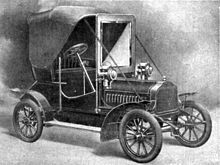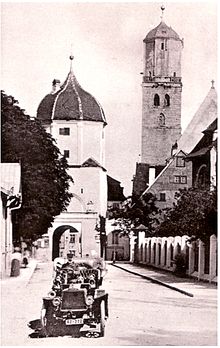Max Wenkel
Max Wenkel (born February 2, 1864 ; † probably 1943 in Berlin) was a German engineer, inventor and automobile pioneer.
Life
Like other automobile pioneers, Max Wenkel began his career as an inventor with the construction of bicycles. As a mechanic's apprentice, he designed his first pennywheel and later successfully competed in races with well-known cyclists such as Willy Tischbein (1871–1946), who later became General Director of the Continental Caoutchouc and Gutta-Percha Company. At the beginning of the 1880s he studied the manufacture of bicycles in England with the future founder of the Adler-Werke , Heinrich Kleyer , and was employed by the Duplex-Fahrradwerke in Berlin.
In 1895 he made successful attempts with a water velocipede (tricycle) on the leash and Ihme near Hanover. As early as 1899 he presented a small car at the 1st International Exhibition in Berlin. From 1901 to 1903 he traveled in a 4-hp Wenkel mobile powered by a Belgian Vivinus engine through the East Indies, Sumatra, Borneo and Java, where he constructed the first German automobiles overseas using primitive means in an improvised small factory. Back in Germany, the Berlin company Schneider & Co produced his Wenkel mobile. With this car he won numerous prizes on touring trips in the small vehicle class. In 1906 and 1907 the inventor traveled with the Wenkelmobil through all of South America to Patagonia. In Argentina he was commissioned to open up the Cordilleras region for road traffic. He also built flat-speed motorized speedboats for Argentine rivers. Wenkel acquired several patents, including for the manufacture of friction disc linings for Wenkel mobiles (1904) and a high-speed compression and vacuum pump (1910). In 1914, Wenkel was listed in the Berlin address book as "Techn. Bur., Innovations-Vertrieb, Kommiss. U. Agent.", 1918 as "Engineer and Prokurist, Techn. Büro". In 1929 he won the renowned Garbaty Cup with his innovative speedboat "Java II" . Three years later he went public with the invention of an "engine in a suitcase", a new type of small car. An article in a boys' book from 1943 suggests that Wenkel died that same year.
Wenkelmobil
Wenkel's first attempt at automobile construction around 1899 was based on a light tubular steel frame and an air-cooled De Dion Bouton engine , which was actually designed for three-wheelers. The drive from the engine to the rear axle was reduced by a chain. A successor model as a four-seater on the substructure of a Break with a more powerful Aster engine with battery ignition and belt drive was already known by its designer as a Wenkel-Mobil. With an improved version with approx. 4 HP he traveled to the Far East in 1901 and built Wenkel mobiles adapted to tropical conditions in Java, where petrol was dirt cheap, based on the model of a light American steam car with a stationary, water-cooled engine installed at the rear and friction or friction wheel drive. It was controlled with a foldable lever. After Wenkel's return to Berlin, the Schneider & Co. automobile works (initially at Siegmundshof 3, but still in 1904 in significantly enlarged factory rooms at Gitschinerstrasse 61) built various models of the initially successful Wenkel mobile. The significantly improved vehicle now had a 7/8 PS single-cylinder engine installed under the hood. The construction of the vehicle was described as follows on the basis of the adjacent picture:
"From the motor a , the face plate b , which serves as a flywheel, is set in rotation and the rotation is transmitted to the disc wheel c . This also rotates the shaft dd on which the chain wheel is keyed . The rear axle is driven by means of the chain e . Adjustment The speed is achieved by moving the disc wheel c on the shaft dd by means of the hand lever located on the left side at the top of the control column and the articulated lever f . The bearings of the shaft dd with the disc wheel c can be moved forward and backward like a slide by the driver's seat on the right located hand lever g . through this lever so that Diskusrad is c with the face plate b and coupled to the motor, or at idle backward against the brake bracket f pressed for the purpose of braking. thus, this lever also serves to brake and clutch. from said brake operate independently the two band brakes r 1 and r 2 on both rear wheels, by the foot lever operated by means of cable s . The beehive cooler n ensures the cooling of the cylinder with the belt-driven pump l . The frame is made of iron-reinforced wood. The front axle is straight, the rear axle is continuous and has no differential gear. "[The independence of the rear wheels was due to the fact that one rear wheel was not driven while the other was rigidly attached to the axle.]
In 1906 a 9/10 hp model was delivered, but in the long term the friction wheel drive and the lack of a differential were not competitive, and in 1907 (Wenkel crossed South America in a Wenkel mobile) production was stopped due to low demand.
Individual evidence
- ↑ Wenkel's year of birth is often incorrectly given as 1874. In a ship's register his place of birth is given as "Ober Bornike", but a place with this name is not known. The date of his death has yet to be determined.
- ↑ ADAC Motorwelt , 1929, No. 7, p. 17
- ↑ Automobil-Rundschau , 1904, Volume 3, p. 431
- ↑ Dinglers Polytechnisches Journal , 1896, Volume 299, pp. 172-179
- ↑ Automobil-Rundschau , 1904, Volume 3, p. 431
- ^ Siegfried M. Pistorius, "Sensation at the turn of the century. Wenkelmobil races through the world" in: Der NSKK.-Mann , August 6, 1938, volume 23, p. 3; August 13, episode 24, p. 10 and August 20, episode 25, p. 10.
- ↑ The archive of the Deutsches Museum in Munich has company publications from Automobilwerke Schneider & Co. List of archive holdings of the Deutsches Museum (S), accessed on February 22, 2014
- ↑ ADAC Motorwelt , 1929, No. 7, p. 17
- ^ Patent bulletin: published by the Imperial Patent Office in 1905 and a US patent: high-speed compression and vacuum pump
- ↑ Die Yacht , 1930, No. 9, p. 22
- ^ Immo Sievers, "The front-wheel drive from Spandau set standards" in: Berliner Zeitung , September 27, 1995
- ↑ Boys - your world! , Volume 6, 1943, page 438. This text is an adapted version of the above-mentioned article by Siegfried M. Pistorius from 1938.
- ^ Journal of the Central European Motor Vehicle Association , Issue XXI, 1904, pp. 431–432
- ↑ Journal of the Central European Motor Vehicle Association , Issue 20, 1906, pp. 499-500 (The confusing sequence of the issue numbers is authentic!)
| personal data | |
|---|---|
| SURNAME | Wenkel, Max |
| BRIEF DESCRIPTION | German engineer, inventor and automobile pioneer |
| DATE OF BIRTH | February 2, 1864 |
| DATE OF DEATH | uncertain: 1943 |
| Place of death | Berlin, Spandau |






